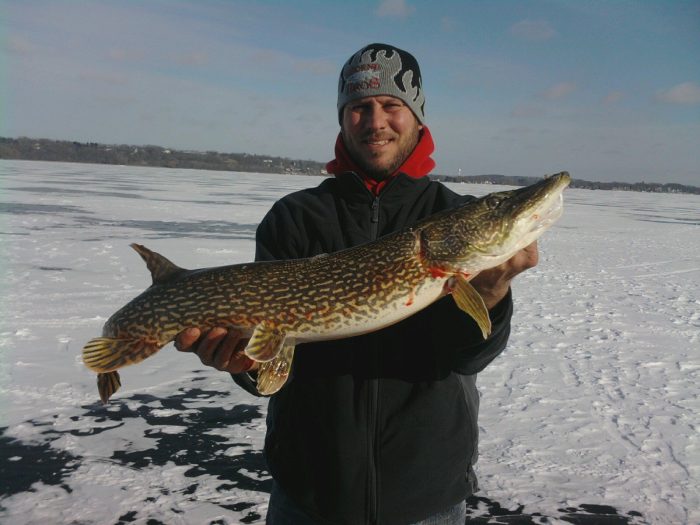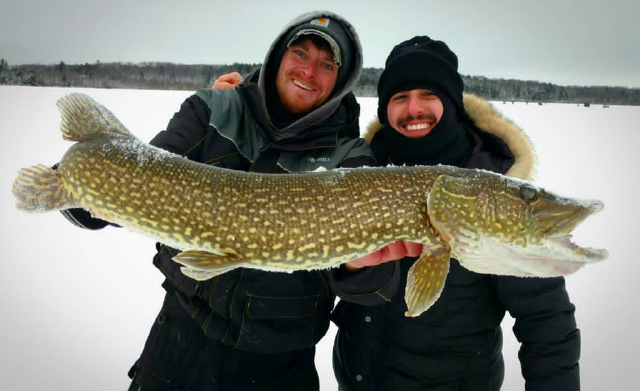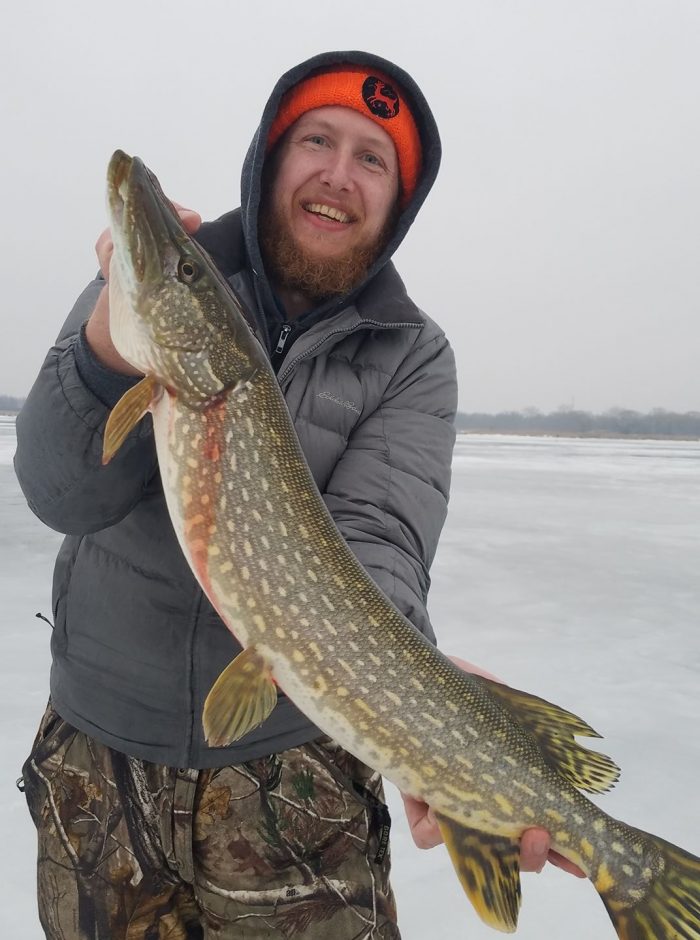Above photo courtesy of WDH Guide Service
Ice fishing for pike and chasing flags all day can be a riot. But lots of action usually means weeding through a lot of smaller fish to eventually pull in a trophy. When the action is hot, your hands get cold. That’s the trade-off. Handling wet braided tip-up line in freezing temperatures, unhooking, observing, releasing, and re-baiting all require a touch of the hands. When it’s bitter cold outside, sometimes the thrill of action can wear off as quick as it showed up.
Targeting bigger fish often means catching less, but the reward can be well worth the wait. Late winter ice fishing is one of the best times of the year to catch trophy pike. Let’s explore the why, when, and where to get in on the action and what to use.
Why Target Big Pike During Late Winter?
As winter progresses, oxygen levels slowly climb in shallow water, especially the bays. The increase of oxygen rejuvenates the underwater world and draws in a lot of panfish. If you notice a trend of pan fishermen moving in shallower and shallower, take note and be prepared to move in yourself.
Cold water slows down the metabolism of any fish and forces them into a lethargic state of being. As a result, big easy meals are the preference for predators like pike, especially big gorged out pregnant pike. With lots of panfish to enjoy, what better place for a trophy pike to hunt than a shallow bay?
When is the Best Time to Target Trophy Pike?
Any time is a good time to catch trophy pike. But their predictability is anyone’s guess leading up to late winter. Usually, February is a good time to start experimenting shallow. However, those last couple of weeks leading up to the close of game fishing season in late February can be money.
The old standby is when the lakes begin to honeycomb with standing water on top of the ice from the thaw are evident. The generation of heightened oxygen levels create a flurry of activity in the shallows. Exercise safety and caution when navigating questionable ice. No fish is worth drowning over.

Where to Target Late Winter Trophy Pike?
Shallow bays are the number one place to start your search for late ice trophy pike. If the lake you are targeting has a shallow bay on the north end, start there. Northern bays will receive the most daylight from dawn until dusk, heating them up faster and promoting the most life.
Spring fed lakes and lakes with current areas from creek and river inlets are sure bets. Oxygen levels will be at an all time high in these areas, as well as warmer water and heightened metabolisms affecting fish using these areas to feed.
Once you settle on an area to fish, don’t settle so easily on which holes to fish. Most shallow bays have weed growth, both old and new. You don’t want your bait presentation to be invisible and masked by a surrounding wall of weeds. Drill multiple holes and look down each to determine which holes will have the most visibility to your bait.
Pike tend to cruise just under the ice, no matter the depth they are swimming. I first learned this while jigging panfish through the ice while sheltered in a shanty over skinny water. The first thing I saw was her nose, then her eyes, and finally her massive head as she inched her way under my hole. I began setting my tip-ups 6-inches beneath the bottom layer of ice and immediately started catching more fish.
Since you’ll be targeting shallower water during the late ice period of February, you don’t want to present your offering too close to the bottom. Pike have eyes set on top of their head, which directs the aim of their vision before and above them. Keep your bait high in the water column and don’t be afraid to hang it as low as 6-12 inches below the bottom of the ice.

What to Use for Bait?
Golden shiners have a lot of flash, but that’s because they are so lively and active. My favorite offering for late season giant pike had been frozen smelt. However, regulations have made using frozen smelt much more difficult. Finding a supplier has also become more challenging, as a result. Since then, I’ve resorted to three different types of bait when targeting trophy pike through the ice during the late season.
Suckers are slow swimmers and tend to be lazy. Sure, they can be fast when they need to be. But I’ve watched enough suckers linger in both the fall and winter to form such an opinion. Even though the areas you’ll be targeting have increased oxygen levels and warmer water, metabolism is still at an all-time low, so big pregnant female pike will be sluggish. By offering dead bait, or a slow-moving sucker, if the right pike sees an opportunity to feed easily, then perhaps you’ve presented the perfect offering.
If I’m unable to get suckers, common golden shiners are almost always available at the bait shop. I’ll buy the biggest shiners the clerk is willing to scoop and head for the lake. Once there, I need to slow them down. Wisconsin anglers are limited to three lines per person, so I’ll usually let one shiner freeze on the ice while I set the other two tip-ups. Then I’ll hang the frozen dead one to see what the fish are in the mood for. As for the live golden shiners, while my wife hesitates to kiss me afterwards, I take a bite off the bottom half of the golden shiners tail and spit it out. Doing so slows down the shiner significantly. They are still able to swim, but they aren’t so lively that a big lethargic pike will pass it up and look for an easier meal.







